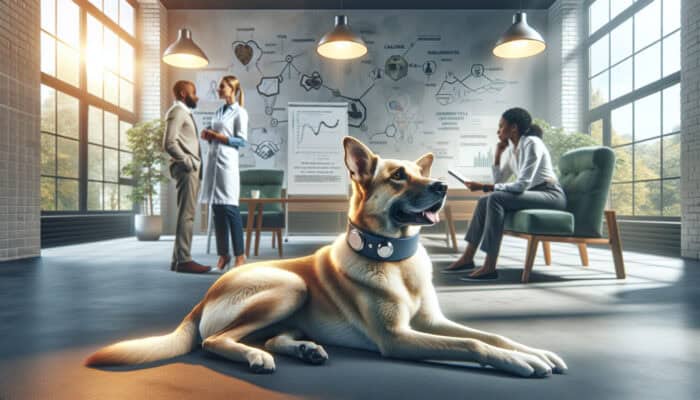Comprehensive Guide to Effectively Using Calming Collars for Your Cherished Pets
Understanding the Purpose of Calming Collars for Pets

Calming collars are innovative solutions engineered to significantly reduce anxiety in pets. They work by releasing calming pheromones or natural calming agents that help create a tranquil state of mind. Designed to be worn around a pet’s neck, these collars operate continuously, emitting a soothing effect akin to a comforting security blanket during anxiety-inducing situations. Many pet owners have recently adopted these collars as a proactive means of managing their pets’ anxiety issues. Just like humans, pets endure stress and anxiety, which can profoundly affect their overall well-being and happiness levels.
To effectively utilize calming collars, it is crucial for every pet owner to comprehend how these products function. These collars deploy natural calming substances that mimic the pheromones produced by pets themselves. This mimicry serves to send reassuring signals of safety and comfort, promoting relaxation during various stressful scenarios, such as thunderstorms, fireworks, visits to the veterinarian, or alterations in their daily schedules. By incorporating calming collars into your pet's routine, you can foster a more peaceful living environment for both you and your beloved companion.
Mechanisms of Calming Collars in Easing Pet Anxiety
Calming collars operate by gradually releasing pheromones or scientifically validated natural calming agents that imitate the soothing pheromones emitted by mother animals to comfort their offspring. As these collars are worn, they disperse calming substances slowly, engaging the sensory receptors of the pet and effectively reducing anxiety and stress. This soothing interaction can lead to a more tranquil demeanor, significantly lessening anxious behaviors like excessive barking, scratching, or hiding.
Using calming collars is particularly advantageous in circumstances where pets are likely to experience transitional stress. This includes moving to a new home, encountering unfamiliar individuals, or being subjected to loud noises such as thunderstorms or fireworks. The steady release of calming compounds provides pets with a reassuring sense of comfort and security, thereby alleviating panic. It’s vital for pet owners to recognize that while calming collars can be beneficial, they should not be seen as a standalone solution for severe anxiety. Instead, they should be integrated within a holistic anxiety management strategy that includes behavioral modifications and environmental adjustments.
Different Types of Calming Collars Available for Pet Owners
A diverse range of calming collars is available on the market, each tailored to address different pets and their specific anxiety triggers. Understanding these variations is essential for selecting the most appropriate collar for your furry friend. The primary categories include collars utilizing synthetic pheromones, essential oils, and herbal extracts.
Collars that utilize synthetic pheromones are designed to imitate the natural scents produced by animals, making them particularly effective for both dogs and cats. These collars closely replicate the scents that convey safety and comfort, providing relief in stressful situations. Essential oils, such as <a href="https://limitsofstrategy.com/lavender-for-family-sleep-a-uk-guide/">lavender</a> and chamomile, are common calming agents found in certain collars. These collars diffuse pleasant aromas known to create a calming effect on many pets.
On the other hand, herbal extract collars rely on natural plant compounds, often composed of a blend of soothing herbs. These collars cater to pet owners seeking a holistic approach to anxiety management. When choosing a calming collar, it’s crucial to consider your pet's individual preferences and sensitivities to ensure both safety and effectiveness.
Significant Advantages of Using Calming Collars for Pets

The advantages of utilizing calming collars for pets are extensive and can greatly enhance the quality of life for both pets and their owners. One of the most significant benefits is the alleviation of stress-induced behaviors. Many pets engage in destructive habits, such as chewing furniture or excessive barking, when they are anxious. By offering a consistent source of comfort, calming collars can help mitigate these behaviors, leading to a more peaceful living environment.
In addition to reducing anxiety, calming collars can enhance a pet's overall quality of life. They enable pets to feel more relaxed during stressful situations, allowing them to explore their surroundings with confidence. This improvement can strengthen the bond between pets and their owners, as calmer pets are typically more affectionate and easier to train.
Furthermore, calming collars provide a non-invasive solution to anxiety management. Unlike medications that may carry side effects, calming collars utilize natural ingredients that are generally well-tolerated by pets. This attribute makes them an attractive option for pet owners seeking safe and effective methods to tackle anxiety issues. By understanding these benefits, pet owners can make informed decisions regarding their pets' anxiety management, ultimately resulting in a happier and healthier animal.
Selecting the Right Calming Collar for Your Pet's Needs
Choosing the most appropriate calming collar for your pet involves considering several key factors to ensure it effectively addresses their specific anxiety triggers. First and foremost, it is essential to identify your pet's unique stressors. For example, if your dog tends to become anxious during thunderstorms, a collar specifically designed to combat sound sensitivity may offer the most benefit.
Another important consideration is the collar's ingredients. Different collars employ various calming agents, and some pets may have sensitivities to particular substances. Consulting with a veterinarian can provide valuable insights and personalized recommendations based on your pet's health history and individual needs.
Additionally, think about the collar's effectiveness duration. Some collars release calming agents for up to a month, while others may have varying durations based on their formulation. Furthermore, reading reviews and seeking recommendations can help ensure you select a reputable product. By taking these steps, you can confidently choose a calming collar that effectively meets your pet's needs, paving the way for a more relaxed and content companion.
Insights from Experts on Calming Collars and Pet Anxiety Management
Expert Recommendations on the Use of Calming Collars

Veterinarians and animal behavior specialists frequently advocate for calming collars as a non-invasive method for addressing pet anxiety. Many professionals view these collars as complementary tools that can be utilized alongside behavioral therapies for optimal results. Experts agree that the most effective strategy for managing pet anxiety involves a multifaceted approach, incorporating environmental adjustments and behavioral training.
To effectively utilize calming collars, experts recommend adhering to the following guidelines:
- Always consult with your veterinarian before initiating any new treatment to ensure it aligns with your pet's specific requirements.
- Consistently use the collar, especially during known stress-inducing events.
- Monitor your pet's behavior and reactions to the collar to evaluate its effectiveness.
- Combine the collar with positive reinforcement training to amplify its impact.
- Replace the collar as recommended to maintain its efficacy.
- Be vigilant for potential skin sensitivities and check for irritation regularly.
- Consider your pet's individual preferences when selecting the collar type.
- Stay informed about new products and advancements in calming solutions.
By adhering to these expert recommendations, pet owners can maximize the benefits of calming collars and enhance their pets' emotional health.
Maximizing the Effectiveness of Calming Collars for Your Pet
To ensure the effectiveness of calming collars, proper usage is crucial. First, ensure that the collar fits your pet comfortably. A well-fitting collar should be snug but not overly tight, allowing for natural movement without causing discomfort. Regularly inspecting the collar for wear and tear is also essential, as damaged collars may not function efficiently.
Integrating calming collars into your pet's daily routine can further enhance their effectiveness. Start by introducing the collar in a calm environment, allowing your pet to associate it with positive experiences. Consistency is critical, especially during recognized stressors such as car rides, veterinary visits, or fireworks displays.
Moreover, combining the collar with other anxiety management techniques can yield even greater results. For instance, providing a safe space for your pet to retreat during anxious moments, along with behavioral training exercises, can create a comprehensive approach to managing anxiety. By implementing these actionable steps, pet owners can ensure that calming collars work optimally and positively impact their pets' overall well-being.
Potential Side Effects of Calming Collars to Watch For
While calming collars are generally regarded as safe for most pets, it is important to remain vigilant about potential side effects. Some pets may experience mild skin irritation or allergic reactions to the materials used in the collar. Symptoms might include redness, itching, or discomfort around the neck area. Closely monitoring your pet's behavior after introducing a new collar is essential.
If you observe any adverse reactions, it is advisable to remove the collar and consult your veterinarian for guidance. They can recommend alternative calming solutions or suggest a different collar that may be more suitable for your pet's individual sensitivities.
Additionally, while most pets adapt well to calming collars, their effectiveness can vary based on individual temperament and anxiety levels. Therefore, maintaining open communication with your veterinarian will help tailor the anxiety management plan, ensuring your pet is comfortable and safe while using a calming collar.
How Calming Collars Benefit Different Types of Pets
Understanding How Calming Collars Aid Dogs with Unique Anxiety Needs
Calming collars can be particularly beneficial for dogs, especially those suffering from separation anxiety or noise phobias that often occur during thunderstorms or fireworks. These collars function by releasing pheromones that closely resemble those produced by mother dogs to soothe their puppies, thereby providing a sense of security and relaxation.
For dogs experiencing separation anxiety, calming collars can significantly lower stress levels when they are left alone. The continuous release of soothing pheromones fosters a calming atmosphere, allowing dogs to feel more at ease in their owner's absence. Additionally, in scenarios where loud noises occur, such as in urban environments or during specific holidays, calming collars can greatly alleviate fear and panic in dogs.
Dog owners should recognize that calming collars yield the best results when employed as part of a comprehensive anxiety management plan. By integrating training and positive reinforcement techniques alongside the use of calming collars, owners can reinforce desired behaviors and further lessen anxiety levels, leading to a more balanced and content pet.
Examining the Benefits of Calming Collars for Cats
Cats can also experience significant advantages from calming collars, particularly those that face stress due to environmental changes or social interactions. Similar to dogs, these collars emit pheromones that emulate those a mother cat uses to calm her kittens, making them feel more secure in their surroundings.
Many cats find comfort in familiar scents, and calming collars can assist them in adjusting to new situations, such as moving to a new home or introducing new pets into the household. Furthermore, calming collars can help reduce anxiety during stressful events like veterinary visits or grooming sessions, creating a more relaxed experience for both the pet and the owner.
When selecting a calming collar for a cat, it is vital to consider their specific triggers and behaviors. Observing the cat's reaction to the collar will help owners determine its effectiveness and identify any necessary adjustments to their anxiety management plan. By incorporating calming collars into their routine, cat owners can foster a supportive environment that promotes emotional well-being.
Calming Collars for Other Pets: Rabbits and Horses
While calming collars are primarily designed for dogs and cats, they may also offer benefits for other pets, including rabbits and horses. However, it is crucial to select a collar specifically formulated for each species to ensure safety and efficacy. For instance, collars designed for dogs may not be suitable for rabbits, given the physiological differences and varying sensitivities.
For rabbits, calming collars can help alleviate stress caused by environmental changes, such as relocating to a new cage or introducing new companions. These collars can enhance a rabbit's sense of security, creating a more relaxed atmosphere in their living environment.
Similarly, for horses, calming collars can assist in managing anxiety during transport or in new settings, promoting calmness and composure. Pet owners should always consult with a veterinarian to ensure that they select the appropriate collar tailored to the specific needs of their pets, regardless of species, to achieve optimal results.
Benefits of Calming Collars for Small Pets, Like Hamsters and Guinea Pigs
Calming collars can also provide significant advantages for small pets, such as hamsters and guinea pigs. These small creatures often exhibit heightened sensitivity to their environments, and alterations in their surroundings can lead to increased stress levels. Calming collars designed for small pets generally contain species-specific calming agents that work to reduce anxiety and foster a sense of safety.
For instance, a small animal may experience stress from being handled or undergoing changes in their habitat. A calming collar can help them feel more secure, enabling them to adapt to new situations without fear. When selecting a collar for small pets, ensure it is appropriately sized and specifically designed for their species to guarantee effectiveness and safety.
Using calming collars with small pets necessitates careful monitoring of their reactions. Observing their behavior after introducing the collar can provide insights into its impact. By creating a calming environment, pet owners can help small pets thrive, experiencing less anxiety and more comfort in their daily lives.
Calming Collars for Birds: Addressing Their Unique Needs
Although less common, calming collars specifically designed for birds can effectively mitigate anxiety stemming from new environments or loud noises. Birds, particularly species sensitive to changes, can benefit from the calming effects of specially formulated collars. These collars generally utilize pheromones or natural ingredients aimed at creating a soothing atmosphere, enabling birds to feel more secure in their surroundings.
When considering calming collars for birds, always opt for products specifically designed for avian use. Collars not intended for birds may contain ingredients that could be harmful or ineffective in addressing their unique needs. Additionally, it is crucial to monitor the bird's response to the collar and consult with a veterinarian if any adverse reactions arise.
In summary, while calming collars are often associated with dogs and cats, they can also be utilized effectively for various pets, including small animals and birds. Understanding the specific requirements of each species and recognizing the potential benefits of utilizing such collars can lead to improved emotional well-being across the board.
Scientific Research Supporting the Benefits of Calming Collars for Pet Anxiety
What Does Scientific Research Reveal About Calming Collars and Their Efficacy?
Research indicates that calming collars can significantly reduce signs of stress and anxiety in pets. Various studies highlight their effectiveness during stressful situations, including environmental changes, exposure to loud noises, and separation from their owners. For instance, research shows that pets wearing calming collars tend to exhibit decreased signs of anxiety, including reduced barking, pacing, and other stress-related behaviors.
Veterinary professionals frequently emphasize the compelling findings that showcase the positive influence of calming collars on pet behavior. Numerous studies provide evidence that pets respond favorably to the pheromones released by these collars, resulting in a significant reduction in anxiety levels. This information is particularly valuable for pet owners seeking practical solutions to manage their pets' anxiety without resorting to medication.
By integrating calming collars into their pets' routines, owners can experience firsthand the research-backed benefits. Consequently, they create a more relaxed and satisfying home environment for both themselves and their pets. Understanding the research behind calming collars empowers pet owners to make informed decisions regarding their pets' anxiety management strategies.
Comparing Calming Collars to Other Anxiety Treatments
When comparing calming collars to other anxiety treatments such as medications, supplements, and behavioral therapies, they often emerge as a non-invasive alternative. Calming collars provide a continuous source of comfort without the potential side effects associated with pharmaceuticals, making them an appealing option for pet owners concerned about medication.
Key advantages of using calming collars compared to other methods include:
- Non-invasive: Calming collars do not require prescriptions or invasive administration techniques.
- Ease of use: Simply place the collar on your pet, and it starts working immediately.
- Continuous support: Unlike pills or supplements that necessitate regular dosages, collars deliver consistent calming effects around the clock.
- Compatibility: Calming collars can be used alongside other treatments, enhancing overall effectiveness.
- Natural ingredients: Many collars utilize pheromones or herbal extracts, appealing to pet owners seeking holistic solutions.
- Minimal side effects: Most pets tolerate calming collars well, with fewer concerns regarding adverse reactions.
In summary, calming collars serve as a practical option for managing pet anxiety, particularly for those who prefer a more natural approach.
Long-Term Effects of Using Calming Collars for Pets
Long-term use of calming collars can lead to sustained lower stress levels in pets. Many pet owners report that consistent usage over time helps their pets adapt to anxiety-inducing situations, allowing them to respond more calmly as they become acclimated to their environments. This gradual desensitization often results in pets exhibiting fewer anxiety-related behaviors, contributing to a more harmonious living situation.
However, ongoing use of calming collars should always be monitored by a veterinarian. Regular check-ups can help ensure that the collar remains suitable for the pet's evolving needs and that the pet is responding positively. In some cases, pets may require additional behavioral training or environmental modifications to effectively manage their anxiety alongside the calming effects provided by the collar.
Through continuous evaluation and adjustment of the overall approach, pet owners can ensure that their pets continue to benefit from the calming effects of these collars while fostering long-term emotional resilience. By recognizing the significance of long-term effects, owners can better understand how calming collars contribute to their pets' overall well-being.
Effectiveness of Calming Collars Across Different Pets
Calming collars have demonstrated general effectiveness for both dogs and cats; however, their efficacy can vary based on individual pets and species. Research indicates that while many dogs and cats benefit significantly from calming collars, their effectiveness may be influenced by factors such as the pet's age, temperament, and specific anxiety triggers.
For instance, younger pets may exhibit a more pronounced response to calming collars compared to older pets who may have developed ingrained anxiety behaviors. Moreover, various breeds of dogs and cats may react differently to calming agents due to their unique sensitivities. In these cases, veterinary recommendations can be invaluable, as they can offer tailored insights based on the individual pet's needs and help pet owners select the most effective collars.
Furthermore, while calming collars can assist in alleviating anxiety in smaller pets and birds, the research in these areas is less comprehensive. Pet owners contemplating calming collars for less common pets should consult with veterinarians to identify the most suitable products and approaches for their specific companions. Overall, while calming collars can be beneficial for many pet types, their effectiveness may vary, and personalized guidance can help achieve the best results.
Essential Considerations for Selecting the Right Calming Collar for Your Pet
Key Factors to Consider When Choosing a Calming Collar
When selecting a calming collar for your pet, it is essential to consider several key factors to ensure that it effectively addresses their specific anxiety triggers. Understanding your pet's unique needs is paramount. For instance, if your pet's anxiety is linked to loud noises, look for collars specifically designed to target sound sensitivity with proven pheromone formulations.
Another critical aspect to evaluate is the ingredients used in the collar. Some pets may have sensitivities or allergies to certain components, so it is essential to read the label thoroughly. Consulting with a veterinarian can provide valuable insights into the best options available, tailored to your pet's health history and individual anxiety challenges.
Additionally, the duration of effectiveness is an important factor to assess. Some collars may last longer than others, and selecting a collar that suits your pet's lifestyle can enhance convenience and efficacy. Lastly, checking customer reviews and recommendations can help identify reputable products that have demonstrated effectiveness for other pet owners, ensuring you make a well-informed decision. By considering these essential factors, you can select a calming collar that is tailored to your pet's individual needs.
Ensuring the Optimal Fit for Your Pet's Calming Collar
Achieving the best fit for a calming collar is critical to its effectiveness. A proper fit will maximize the collar's ability to release calming agents while ensuring the safety and comfort of your pet. Begin by accurately measuring your pet's neck circumference using a flexible measuring tape. This step will help you choose a collar that fits snugly but is not too tight.
Adjustable collars are particularly advantageous, as they allow for customization based on your pet's size and comfort level. It is essential to ensure that the collar is not too loose, as it may slip off, nor so tight that it causes discomfort or restricts movement. Regularly checking your pet's collar for wear and tear is also crucial, as damaged collars may not function effectively.
Taking the time to ensure an optimal fit can enhance the calming collar's benefits, promoting a more relaxed experience for your pet. By recognizing the importance of a proper fit, pet owners can make informed choices that lead to improved outcomes in managing their pets' anxiety.
Where to Find Quality Calming Collars for Your Pets
High-quality calming collars can be sourced from various locations, including pet stores, veterinary clinics, and reputable online retailers. When shopping in-person, visiting a local pet store allows you to examine the collar's materials and engage with knowledgeable staff who can provide recommendations tailored to your pet's specific needs.
Veterinary clinics often stock calming collars that they trust for their patients, making them an excellent source for purchasing high-quality products. Online retailers offer a broad range of options, often featuring customer reviews that can provide insights into product effectiveness. However, ensure that the online vendor is reputable and that the products are endorsed by veterinary professionals.
Before making a purchase, it is beneficial to research various brands and read reviews from fellow pet owners. Seek out products with positive ratings and feedback, as this can indicate the collar's efficacy and safety. By exploring multiple purchasing avenues, pet owners can confidently find quality calming collars that will effectively benefit their furry companions.
Mechanisms of Calming Collars in Easing Pet Anxiety
Calming collars function by releasing pheromones or natural ingredients specifically formulated to alleviate anxiety in pets. When the collar is worn, these calming agents are gradually released, interacting with the pet's sensory receptors. This interaction conveys a sense of safety and comfort, helping to diminish feelings of anxiety and encourage relaxation.
The effectiveness of calming collars often depends on their ability to replicate the natural pheromones produced by animals. For instance, a calming collar designed for dogs may contain synthetic pheromones that imitate those released by a mother dog to soothe her puppies. Similarly, collars designed for cats may incorporate calming compounds that reflect maternal scents.
The continuous release of these calming signals creates a familiar and reassuring atmosphere for pets, significantly reducing anxiety-related behaviors. By understanding how calming collars work, pet owners can appreciate the science behind their effectiveness and make informed decisions about incorporating them into their pets' anxiety management strategies.
Safety Considerations for Using Calming Collars Across Pet Types
Calming collars are generally considered safe for most pets; however, it is crucial to consult with your veterinarian before introducing new products, especially for pets with pre-existing health conditions or allergies. While many calming collars utilize natural ingredients that are well-tolerated, individual reactions may vary based on each pet's unique sensitivities.
Monitoring your pet's response to a calming collar is also essential. After introducing the collar, be vigilant for any signs of irritation or discomfort, such as excessive scratching or redness around the neck. If any adverse reactions occur, it is advisable to remove the collar immediately and seek professional guidance to explore alternative options.
By understanding the safety considerations associated with calming collars, pet owners can take the necessary precautions to ensure their pets' well-being while effectively managing anxiety. Always prioritize your pet's comfort and health by consulting with a veterinarian and diligently observing their behavior.
Best Practices for Maintaining and Utilizing Calming Collars
Optimal Replacement Frequency for Calming Collars
Calming collars typically require replacement every 30 days, although the exact duration may vary based on the product and individual usage. To ensure continuous effectiveness, it is crucial to adhere to the manufacturer's guidelines regarding replacement frequency. Over time, the calming agents in the collar may diminish, reducing its ability to manage anxiety.
Regularly inspecting the collar for wear and tear is also vital. If you notice any signs of damage, such as fraying or fading, it is time to replace it, regardless of how much time has passed. Keeping track of the collar's condition can help maintain its efficacy in providing comfort to your pet.
By following these replacement guidelines, pet owners can maximize the benefits of calming collars, ensuring that their pets continue to receive the anxiety management support they require. Establishing a consistent schedule for collar replacement is key to fostering a relaxed and stable environment for anxious pets.
Best Practices for Effective Use of Calming Collars
Implementing best practices for using calming collars can significantly enhance their effectiveness in managing pet anxiety. Firstly, consistency is essential. Regularly use the collar, particularly during known stress-inducing events, to help your pet associate the collar with comfort and security.
Monitoring your pet's behavior and responses to the collar is also crucial. Observing any changes in their anxiety levels can help determine the collar's effectiveness and inform any necessary adjustments to your anxiety management approach. Furthermore, combining the use of calming collars with other anxiety management techniques, such as training or environmental changes, can yield even better results.
Regular consultations with your veterinarian can help tailor your approach to your pet's needs, ensuring the continued effectiveness of the calming collar over time. By adhering to these best practices, pet owners can create a supportive and calming environment that promotes emotional well-being for their pets.
Combining Calming Collars with Other Therapies for Enhanced Effectiveness
Yes, calming collars can be effectively utilized alongside other therapies, including behavioral training, medication, and environmental modifications. This integrated approach can enhance the overall effectiveness of anxiety management strategies for pets. For example, pet owners may choose to employ calming collars to provide immediate support during anxiety-inducing situations while simultaneously engaging in behavioral training techniques to address the root causes of anxiety.
Utilizing calming collars in conjunction with medication is another viable option for pets experiencing severe anxiety. While calming collars offer a natural solution, medication may be necessary for pets that require additional support to manage their anxiety levels. Veterinarians often recommend this combined approach to ensure a comprehensive treatment plan.
Environmental modifications, such as creating safe spaces or minimizing loud noises, can also complement the use of calming collars. By providing a supportive atmosphere and utilizing calming products, pet owners can help their pets feel secure and relaxed. This collaborative methodology can lead to more effective anxiety management outcomes, ultimately resulting in happier and healthier pets.
Frequently Asked Questions About Calming Collars and Their Use
What Materials Are Used in the Construction of Calming Collars?
Calming collars are typically made from durable materials and infused with calming agents, such as synthetic pheromones, essential oils, or herbal extracts, designed to mitigate anxiety in pets.
How Quickly Can You Expect Calming Collars to Start Working?
Calming collars often begin to take effect within a few hours of being worn, although it may take several days for the full effects to be observed, particularly in pets with higher levels of anxiety.
Are Calming Collars Suitable for Puppies and Kittens?
Yes, calming collars can be used for puppies and kittens; however, it is essential to select products specifically designed for young animals to ensure safety and effectiveness.
Do Any Pet Breeds Not Respond Well to Calming Collars?
While most pet breeds can benefit from calming collars, individual responses may vary. Some pets might require additional support or alternative methods for managing anxiety.
Can Calming Collars Help Alleviate Travel Anxiety in Pets?
Yes, calming collars can be effective in managing travel anxiety in pets, providing a sense of comfort and security during car rides or other travel scenarios.
Are Calming Collars Safe for Pets of All Ages?
Calming collars are generally safe for pets of all ages, but it is always advisable to consult with a veterinarian before introducing new products, particularly for young or elderly pets.
How Can You Tell if the Calming Collar is Working for Your Pet?
Monitoring your pet's behavior can provide insight into the collar's effectiveness. A noticeable reduction in anxiety-related behaviors, such as barking or hiding, indicates that the collar is working.
Can You Use a Calming Collar Alongside a Harness or Other Collars?
Yes, calming collars can typically be used with harnesses or other collars, but ensure that they fit comfortably and do not cause any discomfort to your pet.
What Should You Do if Your Pet Has an Adverse Reaction to a Calming Collar?
If your pet experiences an adverse reaction, such as skin irritation or unusual behavior, remove the collar immediately and consult your veterinarian for guidance on alternative solutions.
Can You Wash a Calming Collar?
Most calming collars are not designed to be washed. It is best to follow the manufacturer's guidelines regarding care, ensuring proper maintenance to retain effectiveness.
Connect with us on Facebook!
The Article Calming Collars for Pet Anxiety: A Comprehensive Guide First Published On https://elgatoencasa.com
The Article Calming Collars for Pet Anxiety: Essential Tips and Insights Was Found On https://limitsofstrategy.com

